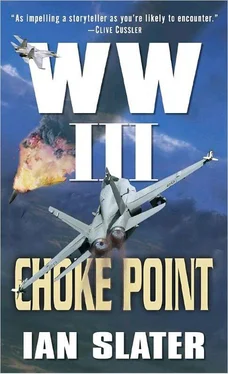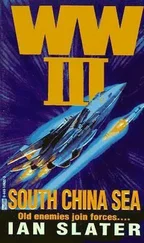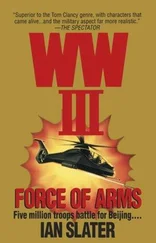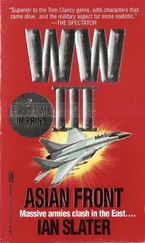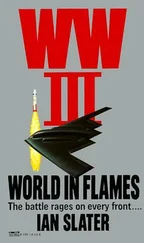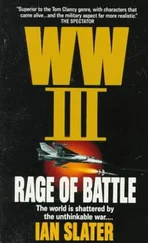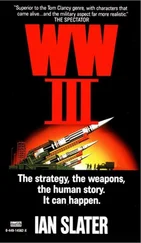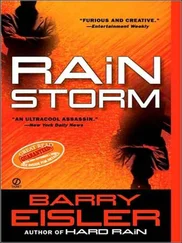A Marine corporal took his squad to make sure the building wasn’t occupied or booby-trapped, everyone shaken, whether they showed it or not, by the sabotaged road. The admiral was confused, because the Marines were proceeding as if the explosion hadn’t damaged the NR-1B, until, in a joyous moment, he saw that, despite the sandy soil and lumps of straw-colored passpalum grass that partially covered the sub’s nose and the elongated conning tower, there was no hole or even a dent evident. But he knew that if even a hairline fracture was discovered, it would mean the integrity of the vessel would be violated. This would prevent the Navy’s state-of-the-art research sub, capable of going to three thousand feet, from diving to even a few feet below the surface.
Feeling as if his heart was pushing an obstruction up into his throat, his breathing becoming increasingly difficult, Jensen approached the craft in a state of incipient panic. With the help of four Marines and his driver, he began brushing off the dirt, sand, and passpalum. “Look carefully,” he enjoined them. “Each of us take a section and go over it with—” He paused, his breathing shallow and rapid. “Carefully,” he said.
“You all right, sir?” asked the Marine CO.
“Carefully,” Jensen repeated.
“Pricks made a hash of it, sir,” said the Marine. “Looks fine. They didn’t use enough C-4. Beat up the truck cabin and the trailer some. But everything else looks hunky dory.”
The admiral heard him but didn’t answer, as if any positive response would jinx his inspection of the one vessel that might find the midget sub and salvage his reputation. He closed his eyes for a moment, the Marine CO thinking he was in pain when in fact he was praying. He remembered what his mother had told him: “Never ask God for anything for selfish reasons — ask that His will be done, not yours.” Jensen prayed that the NR-1B’s structural integrity remained sound. There was no gash in the nose or nacelle that housed the sophisticated side-scan array sonar. No sign of damage on the small conning tower or the mast array housing. “Thank Christ,” he murmured. “Amen.”
“You morons!” Jensen’s driver shouted at the amphitheater of fields and hills to the north. “You screwed up, you al Qaeda bastards!” The admiral felt duty bound to tell him to be quiet, but said nothing. The truth was, his driver was expressing the same surge of relief that the admiral and his Marine escort were now feeling: a release from the pent-up tension wrought by the slow, painstaking drive down from the Naval Air Station near Oak Bay toward the ferry.
Jensen, however, was too experienced a commander to leave anything to chance. He didn’t ream out the Marines as he’d wanted to do when he heard the road explode under the vessel — it would have been virtually impossible to detect the fake road repair that had allowed the saboteurs to feed the det cord and C4 under the bitumen’s surface. Instead he simply told the Marine commander to secure the small ferry terminal, and now decided that he’d send a dive pair down to check the water in and around the dock. For all they knew, the road explosion could be a cover to divert the Marines’ attention away from the dock, where earmuff charges could be placed on the pilings and exploded once the NR-1B was in the water. High-temperature oxyacetylenelike cuts from muff charges could easily sever H-shaped dock pilings and supports, causing them to come crashing down onto the superstructure of the 146-foot-long sub.
Unfortunately, his call to the Coast Guard ended in frustration. The last of their standby divers, Peter Dixon, was with General Freeman, and like all other divers in the strait, Puget Sound, and adjacent waters, he was doing triple time, trying to cope with the most pressing of the myriad diving tasks created by the recent rash of sinkings, including that of the Georgia Queen , most of whose passengers had died. The other thing that frustrated Jensen was the news that apparently Douglas Freeman had gone out without assist from the NR-1B. “I’d’ve thought Freeman would’ve waited for the NR-1B,” Jensen told the USCG admiral in Seattle.
“Maybe, Walt, but you know how Doug Freeman is. Charge!”
Jensen held his tongue. Freeman was a glory hound, but he was also the one who had told Marte Price that it was his — Admiral Jensen’s — idea to send out Darkstar for a “close-in” run along the reverse seven of the Olympic peninsula’s northern Juan de Fuca shore and down south from Cape Flattery to the national wildlife refuge. It had been an unselfish act, Jensen knew, on Freeman’s part to help a disgraced admiral regain something of his reputation after the disastrous loss of the Utah .
“Any of you fellas swim?” Jensen asked the Marines, his question clearly a request for volunteers.
Four Marines immediately stepped forward.
“Just in for a few minutes, guys — long enough to check the pilings. Okay?”
The four men stripped to their skivvies, taunted good-naturedly by their comrades, “Brass monkey balls in there! You won’t last more’n three minutes, cowboy!”
The remaining Marines used their compact field glasses to zoom in on the pilings and launch ramp, seeing nothing suspicious, while the four ad hoc divers plunged in. They were immediately struck by the extraordinary clarity of these Northwest waters. They saw thick clumps of barnacles, oysters, and other marine crustaceans, any of which could hide explosive, which was infamously easy to camouflage. Still, they could see no wires, no det cord. The four Marines’ lips were soon dark blue, bodies shivering as uncontrollably as David Brentwood’s had the previous evening at Port Angeles.
“Looks clear, sir,” the Marine CO informed the admiral, adding a caveat for his own protection. “ ’Course, you never know.”
Jensen hesitated, wondered and worried. Apart from anything else, this was a billion-dollar machine in his charge.
“What’s that?” asked one of the Marines, pointing to a dot, obviously some kind of vessel, coming from the direction of Port Townsend, ten miles southwest across Admiralty Inlet.
The dot on the inlet’s cobalt blue was Washington State’s Port Townsend — Keystone ferry, due to arrive at Keystone in twenty-five minutes.
“What the hell’s it doin’?” asked a gum-chewing Marine.
It was the question on everyone’s mind. Surely the carnage unleashed in the last seventy-six hours argued against any resumption of normal ferry traffic.
“What if they’ve taken over the ferry, Admiral?” the Marine CO asked.
“Using it to stop our launch,” said the admiral, “now that they’ve seen their road mining didn’t work.”
No one knew who “they” might be, but the sinking of billions of dollars of U.S. naval ships clearly had been done with the aid of damn good intelligence. They’d known precisely where the ships would be and when . And it was more than likely that the same HUMINT who had informed the terrorists of this would know the “road-blow” had failed to perforate the high-tensile steel of the NR-1B.
Jensen wasted no time and ordered one of his COMSUBPAC-9’s two 170-foot Coastal Patrol ships that normally serviced Hood Canal and Puget Sound to intercept the suspect Townsend-Keystone ferry with all possible haste, to stop the ferry and have a boarding party investigate.
“Any resistance,” Jensen instructed the Coastal Patrol ship’s captain and thirty-two-man crew, “is to be met with deadly force. I say again, deadly force.”
The two Hurricane-class Coastal Patrol Ships, unlike the three Hurricanes commanded by USCG Seattle, were on picket duty in Hood Canal, their sole responsibility to guard the entrance to Admiralty Inlet and the waters north and south of the Hood Canal bridge. It was through the Hood Canal’s retractable section that Jensen’s U.S. Hunter Killer and Boomer ballistic missile subs had to pass during their egress from Bangor Base, through the strait, on their way to open, rolling ocean west of Cape Flattery. While one of COMSUBPAC-GRU-9’s two Hurricanes remained on station at the sabotage-susceptible bridge, the other, the USS Skate , primarily responsible for the waters north of the bridge, set off immediately into the Prussian blue stretch of Admiralty Inlet, toward the suspect ferry eighteen miles to the north.
Читать дальше
